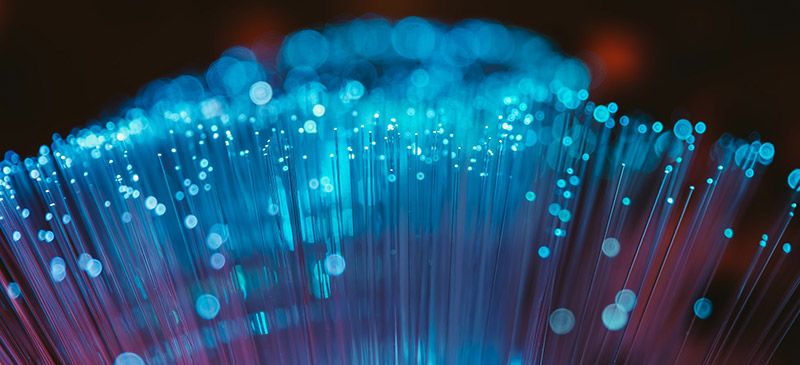What is the difference between FTTC, FTTP and FTTH?
23rd February, 2021 | Home / Blog / Broadband speed / What is the difference between FTTC, FTTP and FTTH?Reading time: 7 minutes

Every industry has its share of jargon, and internet service providers are no different. Some of the most common and confusing acronyms you may have heard are fibre-to-the-cabinet (FTTC) and fibre-to-the-premises (FTTP).
To understand either of these terms, you first need to understand fibre optic cables. Essentially, fibre optic cables cleverly transmit information through them using light rather than electricity. This means information travels thousands of times quicker through them compared to copper cables, which use electricity.
What is FTTC (fibre-to-the-cabinet)?
FTTC stands for fibre-to-the-cabinet. With an FTTC connection, fibre optic cables are used to bring internet to fibre cabinets, the small green boxes you see relatively often out in the streets. However, copper cables are used to connect houses to the cabinet. FTTC is the primary means that most of the country get their internet. In the UK, 98.8% of fibre connections in the country are FTTC, so you have definitely used FTTC internet at some point in your life.
What is FTTP (fibre-to-the-premises)?
FTTP stands for fibre-to-the-premises and is a much newer type of connection, previously having been used mainly for businesses and institutions which needed very robust connections. FTTP connections use fibre optic cables to transfer internet between the cabinet and the home, meaning at no point are copper cables used. For a slightly longer explanation, visit our fibre-to-the-premises (FTTP) page.
FTTC v FTTP
Both types of connection have some positives and negatives- here is a handy list.
FTTC pros:
- Easily accessible – an estimated 9 in 10 UK houses can get an FTTC connection, and new connections usually only require a short installation.
- Adequate speeds – FTTC connections offer sufficient internet for average home use.
- Affordable – most FTTC connections are cheaper than their FTTP counterparts.
FTTC cons:
- Copper cabling limits upload and download speeds.
- The further a premise is from a cabinet, the worse the service quality is.
FTTP pros:
- The fastest available home broadband – up to 1 Gigabit a second or even higher!
- Unlike FTTC, upload speeds can go as high as download.
- You can save some money on packages by not needing to pay phone line rental.
FTTP cons:
- Very limited availability – only 1 in 50 homes can get it (although Airband is working on improving that ratio!)
- Long set up time – installs in a live area take only a few hours, but FTTP networks take a lot more time to build than FTTC ones, so you may need to be patient.
Should I get FTTC or FTTP?
If you have the luxury of a choice between the two services, it can be tricky to tell which one is best for you. We’ve made some lists of the types of needs that each service is best for to help you out.
FTTC might be for you if…
- The budget is a little tight at the moment
- You live on your own, or with one other person
- You don’t use multiple high quality streaming services at the same time
FTTP might be for you if…
- You frequently upload or download large files
- You live with four or more active internet users
- You rely on video calls for work
As the demand for FTTP connections grow across the nation, Airband is aiming to build to tens of thousands of new homes each year. If you want to know if you are within our constantly expanding FTTP network, use our broadband coverage checker.
What does FTTP stand for?
FTTP stands for fibre-to-the-premises. It’s also known as fibre optic or fibre broadband. It uses fibre optic cable to get a fibre broadband connection to your property.
Why can’t I get FTTP?
You might not be able to get FTTP for several reasons:
- You may not live close enough to the nearest street cabinet.
- Demand in your local area may be too high at the moment.
- The internet provider you’re enquiring with might not have the capacity to get to you right now
Why is FTTP better?
FTTP is better than fixed wireless broadband because it’s made from stronger stuff. FTTP uses fibre optic cable to transmit data. But FTTC uses copper cables to send the data signals, so it’s much slower. Copper cable can take 40 Gbps. FTTP does it, almost, at the speed of light.
Is FTTH and FTTP the same?
Yes, FTTH and FTTP is the same. FTTH means fibre to the home, and FTTP means fibre to the property, but they refer to the same technology.
How do I know if I have FTTC or FTTP?
You can check with your internet provider to see if you have FTTC or FTTP. You can check the name of your broadband plan.
What’s the difference between FTTH vs FTTP?
The difference between FTTH, or fibre-to-the-home, and FTTP (fibre-to-the-premises), is nothing. They’re two terms that get used interchangeably. Both FTTH and FTTP refer to ultrafast, reliable fibre broadband.
You can check if you’re in range for fibre broadband now.
Check availability:
Alternatively, you might like:
Related Articles
Check availability:


